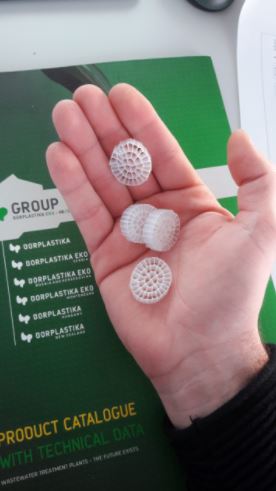Implementation of Moving bed biofilm reactor technology in production processes
Bor-plastika d. o. o. is a fast-growing private company from Croatia with a wide array of thermoplastic products. Simultaneously with the constant improving of their production technologies, the company further diversified their selling programme with the devices for wastewater and air treatment. One of the accomplishments is also a newly developed method for treatment of different types of wastewater.
Comparison of the components size
The company initially wanted to improve the process of aerobic biological wastewater treatment plants/devices with the ”Moving bed biofilm reactor” (MBBR) technology and biomass carriers. Such combination is especially useful in situations with considerable differences in the level of hydraulic and organic load in the wastewater – for example in hotels, apartments and weekend resorts. Since the company used annually more than 200 tonnes of thermoplastic, they wanted to implement new technology to decrease dimensions of the wastewater treatment device and at the same time to lower use of raw materials, but not at the cost of lower efficiency. To achieve this goal, the company started collaboration with the researchers at the Jožef Stefan Institute (The Department of Systems and Control) and at the Iberian Nanotechnology Laboratory (Portugal).
Video presentation of the collaboration between the company and the resaerchers (in the project participated researchers from the Department of Systems and Control at the Jožef Stefan Institute (Slovenia))
During the research project with the company, researchers from the Department of Systems and Control participated with their experience and expertise on the wastewater plants modelling to present complex systems in a more comprehensive way. With the help of models and comparison of different characteristics like the mass of treated wastewater and different conditions in the treatment process, they presented how the wastewater treatment plants/devices should be designed with the MBBR technology. The modelling was influenced with one of the prevalent directions of their research activities – to develop systems and devices for practical use in the industry, along with the products for the market.
Result
The implementation of the MBBR technology resulted in a reduced amount of raw materials, needed in the production, leading to savings in almost all phases of the production process.
Additionally, the quality of treated water improved and the research project proved to have environment-friendly impact. Important factor of the success was the use of biomass carriers with the special nanocellulose material, contributing to more control over the conditions to improve the efficiency of the device without affecting functionality and preserving low costs for the final user.
In the process of finding solution was included also the Center for Technology Transfer and Innovation at the Jožef Stefan Institute with providing support from the first contact, through the development period and to the final phases of the project. The company from Croatia was initially looking for technological partners for co-development in their region, but since none were found, they established contact and within the project KET4CleanProductions they soon started to cooperate with two international technology centers. At the Center for the Technology Transfer and Innovation we are proud on the accomplishment of the researchers from the Department of Systems and Control and how they contributed to the final design of the wastewater treatment device.
The device for biological wastewater treatment
Cooperation took place under the frame of the project KET4CleanProduction, where additional presentation of this succes story is available.
The research project was formed and financed with the support of the Center for Technology Transfer and Innovation at the Jožef Stefan Institute.



